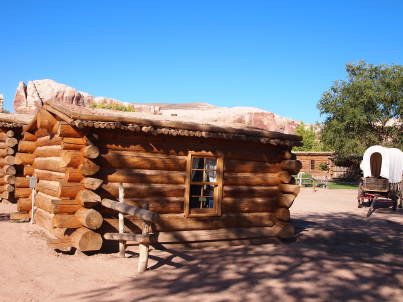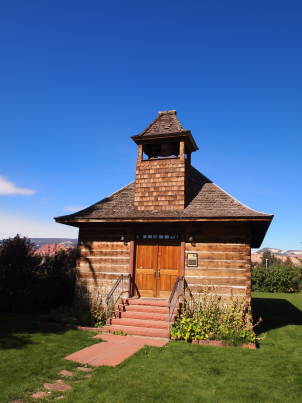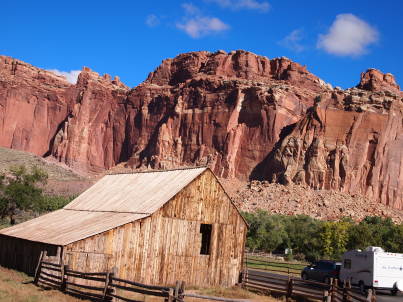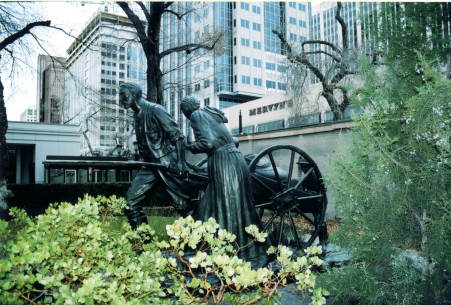On the Mormon Trail - Ian Mitchell
 With the selection of Mitt Romney as the Republican hopeful in America's Presidential election in November 2012, the USA has its first ever Mormon candidate for the White House, and many people are curious as to what Mormonism represents.
With the selection of Mitt Romney as the Republican hopeful in America's Presidential election in November 2012, the USA has its first ever Mormon candidate for the White House, and many people are curious as to what Mormonism represents.
Here we print an extract from the chapter On the Mormon Trail from Ian Mitchell's forthcoming book, Encounters in the US Mountain West, (The In Pinn, September) based on his several trips to the Mormon heartland of Utah and the surrounding states.
On The Mormon Trail
The early Mormon settlers who came to Utah from the 1840s onwards had a harder time of it in getting there, than I had had. Indeed the establishment of Deseret in the desolate Great Basin area by the Latter Day Saints stands, ungainsayable even by their detractors and critics, as one of the great epics of courage and endurance in human history. The Exodus of the Jews from captivity in Pharaoh's Egypt to seek the Promised Land, and the Great Trek of the Boers from the Cape to Transvaal are possibly better known examples of religiously inspired migrations, but it is doubtful if even those experiences can compare with the hardships and sufferings which were experienced by those on the Mormon Trail. Only the Long March of the Chinese Communists in the 1930s can surpass, in heroism, hardship and suffering, the rigours of the Mormon exodus.
Starting from Nauvoo in Illinois, the Mormon Trail stretched 1500 miles though Nebraska, where they established Winter Quarters by the Missouri, and then went through Wyoming and across the mountains to descend into what was to become Utah at the Great Salt Lake. The Mormon settlers were driven to undertake this exodus by the persecutions they suffered in a country one of whose foundation stones was supposed to be freedom of religious worship. Until the coming of the railways in the 1860s, the Mormon Trail was the route taken to Utah by a total of around 70,000 Saints looking for isolation, and "the land nobody else wanted."
To many people, Mormonism is the quintessentially American religion. Not only is it the only widespread faith to have originated in the USA, Mormon theology has a third testament to add to the one of the Jews and the two of the Christians, and most of the events in that testament, the Book of Mormon, reputedly took place thousands of years ago in what is now the United States and the various countries of Central America. For good measure, Jesus Christ is supposed to have visited America after his death, according to the Saints. It truly is a religion Made in the USA. Yet it is also without doubt the one religion which was historically persecuted there beyond all others; anti-Semitism and anti-Catholicism have a long heritage in the USA but neither of these groups came anywhere near to experiencing the suffering and persecutions undergone by the Mormons, which included the cold-blooded murder of the religion's founder, Joseph Smith.
This past persecution has made the LDS church intensely sensitive to any criticism, and rather in the way that any criticism of Judaism and/or the state of Israel and its policies tend to lead to an automatic salvo of accusations of anti-Semitism, so it is very difficult to discuss Mormon theology and history in a critical way with its adherents. For any persecuted faith or political creed, there eventually has to be a moratorium on allowing past persecution to disallow critical comment, but this has yet to come with LDS adherents. It is a long time since Mormons were persecuted and in that time many other groups have suffered discrimination and outright persecution at the hands of US Democracy - the Native Americans, the Afro-Americans, and the labour and trades union movement. However, the Mormons undeniably did undergo atrocious persecution and they responded to this with what, whatever one thinks of their theological beliefs, is undeniably a great epic of endurance, courage and heroism in getting to and establishing Deseret.
In 1830 in New York Joseph Smith founded a church which would soon become known as the Church of Jesus Christ of Latter-Day Saints. He claimed to have found and translated a document, the Book of Mormon which became the foundation of the new religion, hence the appellation Mormons. This document was revealed to him by an angel, called Moroni, and was written on gold plates in a language Smith called Reformed Egyptian, a language as yet unknown to classical scholars. Professor Anthon, at that time America's greatest classical scholar was shown a written copy of some of the script of the alleged book and pronounced the project a fraud, which did not stop LDS members subsequently claiming his endorsement. The alleged plates were taken back by the angel, but not before various people had testified to having seen them, including persons later expelled by Smith from the Church as "counterfeiters, thieves and liars" - which might lead one to question their reliability as witnesses. Others accused Smith and his collaborator Sydney Rigdon of having plagiarised an unpublished novel by the deceased author Solomon Spaulding, The Manuscript Found for much of the material in the Book of Mormon. However, in fairness, this unpublished work disappeared and we only have the testimony of people who claim to have read or seen it that it actually existed- rather as we only have of the Book of Mormon itself.
Under Smith's charismatic leadership, and at a time of widespread religious revivalism in the USA, the new church rapidly made converts. Persecution however drove the LDS relentlessly west, first to Missouri where many atrocities were committed against them, including the favoured tarring and feathering of adherents to the new faith. The massacre of over 20 men women and children at Hauns Mill in 1838 led to the formation of the para-military Danites, an armed militia which defended the LDS faithful and occasionally extracted vengeance on their Gentile ( as the LDS called non-believers) persecutors. By 1839 the church had been driven further west to Nauvoo, Illinois, where it remained till 1846. The population of the city planned and laid out there grew to 11,000 and the economic success of the newcomers, and the fact they had a powerful private militia - and practised polygamy- aroused fear and resentment. Hostility to the Mormons was also aroused by the fact that they were opposed to slavery, something Smith broadcast widely when he attempted to stand for US President in 1844, on a platform far more enlightened in this and other ways, than that of his established rivals, as his Address to the American People testifies.
 By this time as General of the Nauvoo Legion, which was in effect a well-armed and trained Mormon army of several thousand men, Joseph Smith was the undisputed temporal and spiritual leader of what was a state within a state in Illinois. In June 1844 Smith and his brother Hyrum were arrested, charged with High Treason against the state of Illinois, and subsequently murdered by a mob in Carthage. Consequently many more Mormons were killed and burned out of their homes, and the position of Nauvoo became untenable. In agreement for being allowed safe passage west and the disposal of their property, the Mormons disarmed the Nauvoo Legion (at least for the time being) and began the evacuation of Nauvoo, which had become a ghost city by 1847. They were led in their exodous by Brigham Young, who replaced Smith a LDS leader after the latter's death.
By this time as General of the Nauvoo Legion, which was in effect a well-armed and trained Mormon army of several thousand men, Joseph Smith was the undisputed temporal and spiritual leader of what was a state within a state in Illinois. In June 1844 Smith and his brother Hyrum were arrested, charged with High Treason against the state of Illinois, and subsequently murdered by a mob in Carthage. Consequently many more Mormons were killed and burned out of their homes, and the position of Nauvoo became untenable. In agreement for being allowed safe passage west and the disposal of their property, the Mormons disarmed the Nauvoo Legion (at least for the time being) and began the evacuation of Nauvoo, which had become a ghost city by 1847. They were led in their exodous by Brigham Young, who replaced Smith a LDS leader after the latter's death.
Before his death Smith had already contemplated a move West and the area around the Great Salt Lake was a prime candidate, since he was appraised of the results of the Freemont Expedition of 1842-44, which talked of its settlement potential, and he had a map of the area. One reason for the move West was that the early Mormons were millenarian, ie. they believed that the end of the world was nigh. Smith himself foretold that the millennium would come after a war between the states of the USA, and it was believed that one of the few places spared would be the mountain West. Millenarianism is, like many other early Mormon tenets such as communitarianism and polygamy - something that present day adherents of the faith tend to try and forget, but it was a powerful motive in the drive west, and it led to the original stipulation that all converts from wherever they were recruited in the world must move to Utah if they wished to be saved, literally and metaphorically. Whilst one would not wish to doubt the sincerity of these millenarian beliefs, they paradoxically acted as a powerful impulse to secular state - building. The gathering of the saints for the end of the world meant that their collective residency in Utah made the society they set up whilst 'waiting for the end' much more viable than it otherwise would have been.
Unlike the individualistic, free-enterprise nature of most of the westward migration in the USA, that on the Mormon Trail was highly organised and collectivist. The Mormons established various staging posts, ferries and other facilities along the route they pioneered in 1846, and left detachments at key points to help the migrants; they even planted crops along the way for provisions for subsequent following parties. The migrants were divided into companies along military lines, with strict discipline being imposed on the members. In 1849 Brigham Young established the perpetual Emigration Fund to bring future settlers to Deseret, not only from the eastern USA but from Europe and further afield. This meant poverty stricken immigrants could be assured of not only a highly efficient emigration organisation from Liverpool to Salt Lake, and one that would not fleece them, but also would be carried free of charge, with the stipulation that they paid back the costs of travel over time, thus enabling other immigrants to follow. For many of the European emigrants the attraction of a guaranteed passage to a new life and guaranteed employment when there must have weighed as much in their decision to convert to the LDS Church as did any theological attractions of the new faith.
Mormon wealth has led to the restoration of Nauvoo, including the homes of Brigham Young and Joseph Smith as well as that of the original Temple. It is a place of pilgrimage for many of the LDS faithful today. From there the trail crossed the Mississippi and followed the already well-established Oregon-California trail towards the Missouri, where an advance party had already established a way station at Garden Grove with 40 houses for those who would follow on the main exodus. It was important to cross the ice-bound river and establish Winter Quarters on the far side, so that the party could head further westwards when the trail became passable in the Spring of 1847. There is a very fine painting of Winter Quarters, in a rather naive untutored style, by the Mormon artist C.C.A. Christisen which shows the highly-organised nature of that particular way-station. Crossing the plains of Nebraska the Saints were following the well-established and well-protected (by a series of US Forts) trail to the west, such as Fort Laramie. Further west they established Mormon Ferry on the Platte River, another of their infrastructural innovations to aid Saints - and charge Sinners - to cross.
The Trail then crossed the Rocky Mountains and eventually arrived at Fort Bridger, where the Mormon travellers deviated from the Oregon-California Trail and found the hardest part of their journey awaiting them. Trying to follow the faint trail of the ill fated Donner Reed party, which had passed this way in 1846 and had eventually perished in the Sierra Nevada, the Saints fought their way down Echo Canyon and after many travails, eventually broke through into the low lands around the Salt Lake. Legend has it that when BrighamYoung, the Moses of the Mormons, first saw the Great Salt Lake and its surroundings, he uttered the words, "This is the Right Place."
Although a reputed 6,000 people died on the Mormon Trail most of these deaths were as a result of natural causes, or of disease - such as dysentery which was little understood at that time and a constant danger from tainted water supplies. The semi military organisation of the LDS meant that there were few actual disasters, and even those that occurred, their highly efficient organisation helped minimise. To expedite and cheapen the emigration of the Saints, some parties were equipped not with wagons but with handcarts which they pulled with all their belongings. It was felt that these could move quicker and be more able to negotiate difficult ground, than wagons. Many of the handcart emigrant groups were successful, but two parties in 1856 were caught in early blizzards. Rescuers sent out to help managed to save over 800 of the total of 1000 travellers involved.
 The Mormon Trail ends at the This Is The Place park on the eastern edge of Salt Lake City. This is not a state park or other government institution, but a charitable trust run as an uncritical celebration of Mormon history and culture rather than as an educational institution. There is lots of folksy homely celebration of the past and lots of dressing up amidst the buildings of Old Deseret as the virtual reality village is designated. Some of these are replicas, some originals moved here from elsewhere such as Brigham Young's farm. In a way the most interesting aspect of the place is the huge almost Stalinist sculpture outside the main gate of the park, erected on the centenary of the arrival of the first Mormons in 1847. Inscribed on this is a biblical extract which shows that the Mormons did indeed apparently believe they were living in the Last, or Latter Days when they came to Utah originally, "And it shall come to pass in the last days that the mountain of the Lord's house shall be established." (Isaiah 22.35.1)
The Mormon Trail ends at the This Is The Place park on the eastern edge of Salt Lake City. This is not a state park or other government institution, but a charitable trust run as an uncritical celebration of Mormon history and culture rather than as an educational institution. There is lots of folksy homely celebration of the past and lots of dressing up amidst the buildings of Old Deseret as the virtual reality village is designated. Some of these are replicas, some originals moved here from elsewhere such as Brigham Young's farm. In a way the most interesting aspect of the place is the huge almost Stalinist sculpture outside the main gate of the park, erected on the centenary of the arrival of the first Mormons in 1847. Inscribed on this is a biblical extract which shows that the Mormons did indeed apparently believe they were living in the Last, or Latter Days when they came to Utah originally, "And it shall come to pass in the last days that the mountain of the Lord's house shall be established." (Isaiah 22.35.1)
Although they may have come to the Great Salt Lake to prepare for a passage to the next world, the Mormons showed that whilst they were condemned to live in this one, they would make it as comfortable as possible. By evening on the first day of their arrival, the pioneers had begun cutting the first irrigation channels in their attempt to transform the wilderness into a land flowing with milk and honey, the next day they planted their first potatoes. Deseret means, according to the Book of Mormon, the honey bee, and the beehive became the symbol of Utah, and one very relevant to the Mormon-created society of hard work, order and social conformity which the icon represented. These values allowed the Mormons to prosper more than most who emigrated westwards at this time, which even hostile critics had to acknowledge. When Isabella Bird, author of A Lady's Life in the Rocky Mountains, passed through Utah in 1879, she commented favourably on the transformation of the land around the Great Salt Lake, (without being able to resist a snobbish, catty codicil),
'Along its shores by means of irrigation, Mormon industry has compelled the ground to yield fine crops of hay and barley, and we passed several cabins from which, even at that early hour, Mormons, each with one or two wives, were going forth to their day's work. The women are ugly and their shapeless blue dresses hideous.'
It is no exaggeration to say that in the 1850s and 60s and even 70s, Utah was a theocracy. The Mormon church was not a democratic organisation, rather it was organised-like the Catholic Church- top downwards. Brigham Young, whatever official position he held or did not hold, held actual power in Utah, and apart from the LDS church the only other power base was a small detachment of US troops stationed in the territory. Young ruled through the power of the church and the devotion of his followers, but he also ruled in part by force. On occasion unwelcome Gentiles were driven out of the area by the para-military Danites and force was also used against the not negligible dissident LDS groups who challenged Young, such as the followers of Joseph Morris who in 1856 declared Young an impostor, and who, along with several of his followers was killed at a shoot-out in Weber Canyon.
The Danites entered literature through the first Sherlock Holmes detective novel A Study in Scarlet, where they are portrayed by Conan Doyle in the most negative terms. Though Doyle's picture of the Danites is doubtless an extreme exaggeration, to minimise or even deny their existence as many in the Mormon church do today would appear to be equally so. The evidence may be thin, but given the secret nature of the organisation, once would expect it to be so. ( A more sympathetic view than the general demonization of the LDS Church that has taken place in literature is given in the Icelandic Nobel Prize winning novelist Halldor Laxness' Paradise Reclaimed, an historical novel about the early Mormon settlers.)
Brigham Young had fewer divine inspirations from God than Joseph Smith, but he certainly was a more astute politician and state builder. It is unlikely that Mormonism would have survived had he not been at the helm after Smith's death and through the early pioneer years in Utah. He realised, after the annexation by the US from Mexico in 1848, of the territory in which the Mormons were settling, that any dreams of an independent Deseret were dead, and so he strove for statehood for Utah - with an inbuilt and guaranteed Mormon dominance- within the Union. In 1850 he managed to get the US Government to appoint him Governor of the Utah Territory (one much reduced from the original territorial claims of Deseret) and began to work towards statehood, though always holding the threat of rebellion in hand as a bargaining counter. During the so-called Mormon War of 1856-7 when President Buchanan revoked Brigham Young's governorship and sent US troops into Utah, the Mormons reacted with an effective guerrilla campaign which destroyed the army's supplies and left them impotent without a shot being fired. Full-scale war would have been disastrous for the Mormons, and Young avoided it.
Again when further military forces were sent to Utah in 1862 to "subdue the obstreperous Mormons" in the words of their commander Colonel Connor, Young was careful not to engage them in open military conflict - instead he and other LDS members made a lot of money selling them supplies when they set up a fort in Salt Lake City! Milking the gentiles could be a profitable policy, as for example when the town also prospered and grew as a base for supplying emigrants to California and other western locations. Mark Twain described the place in 1872 as being,
......a city of fifteen thousand inhabitants with no loafers perceptible in it; and no visible drunkards or noisy people...block after block of trim dwellings built of "frame" and sunburned brick- a great thriving orchard and garden behind every one of them.......a grand general air of neatness, repair, thrift and comfort around and about and over the whole. And everywhere were workshops, factories, and all manner of industries; and intent faces and busy hands were to be seen wherever one looked; and in one's ears was the ceaseless clink of hammers, the buzz of trade and the contented hum of drums and fly-wheels. - before allowing himself to comment in a typically mischievous Twainite way, of anyone criticising Brigham, polygamy or any other Mormon tenet that "next morning at daylight such parties are sure to be found lying up some back alley, contentedly waiting for the hearse."
Salt Lake City has a symbolic significance for Mormons, it is their Holy City as Mecca is for Muslims, Rome for Catholics and Jerusalem for the Jews. And like these other cities, Salt Lake abounds in historical and iconographic buildings and monuments proclaiming the LDS message. It is thus unique amongst American cities, and for an urban-historical anthropologist like myself, hugely interesting. An additional factor that attracted me to SLC was that, like Aberdeen, my native town in Scotland, the public buildings are largely constructed in grey granite. But that apart, the "clean, well-lighted place" as Hemingway described it in one of his stories, is in many ways a unique urban experiment, the street-plan of a faith.
 I am writing a travelogue, not a tourist guide; these to Salt Lake City are legion. But I would strongly recommend anyone to take the tour of the main Mormon buildings around Temple Square, as do 4 million visitors each year. They are pleasantly laid out, with gardens and walkways and feature several statues commemorating events within the Mormon epic. One shows a couple pulling a wheelbarrow with all their possessions, commemorating those who travelled the 1500 miles of the Mormon Trail this way, and especially those who perished in 1856. Another monument is dedicated to the seagull, testifying to a "miracle" which occurred when this bird arrived to eat the grashoppers which were destroying the Mormon crops. The omnipotent Diety had send the birds to save his chosen flock; my immediate thought was, who sent the grasshoppers, if not the omnipotent Diety?
I am writing a travelogue, not a tourist guide; these to Salt Lake City are legion. But I would strongly recommend anyone to take the tour of the main Mormon buildings around Temple Square, as do 4 million visitors each year. They are pleasantly laid out, with gardens and walkways and feature several statues commemorating events within the Mormon epic. One shows a couple pulling a wheelbarrow with all their possessions, commemorating those who travelled the 1500 miles of the Mormon Trail this way, and especially those who perished in 1856. Another monument is dedicated to the seagull, testifying to a "miracle" which occurred when this bird arrived to eat the grashoppers which were destroying the Mormon crops. The omnipotent Diety had send the birds to save his chosen flock; my immediate thought was, who sent the grasshoppers, if not the omnipotent Diety?
The two main buildings (there are many more) on the Square are the Tabernacle and the Temple. The former, completed in 1867, you can enter and it is an amazing hemispherical construction built with the use of hardly a nail as the Saints did not possess the requisite amount of iron. The wooden timbers for the Tabernacle roof are bound together by wooden pegs and rawhide thongs. Almost as an accidental by product of this the building has a near perfect acoustic, and is the home to the Mormon Tabernacle Choir. The Temple stands across from this, topped by a gold leaf covered copper statue of the angel Moroni, and the building took 40 years to complete, from granite quarried over 20 miles away. Only LDS members may enter its portals, inside of which are apparently rooms showing what Heaven is like.
Heaven fills me with Horror, at the thought of the eternal tedium of sameness it must possess throughout eternity. The only religion which offers us real delivery is Bhuddism, as in the attainment of Nirvana we cease to exist, cease to be re-born in the infernal cycle of existence. But as a rationalist I can trust in that outcome anyway, without the mantras and the prayer flags. And whilst the Temple is a monument to the LDS faith, and to the overcoming of various architectural problems, as a building it is stark and bare. Granite is a brutal material, that needs ornamentation to soften its impact, and there is little of that on the Temple. But that may just be me, I wasn't too impressed by St Peter's in Rome either.
Salt Lake City has changed in many ways since my first trip at the back end of the last century. In an attempt to get the Winter Olympics in 2002, the drink laws of Utah were relaxed, and this in turn has created a pub/club culture that was not in evidence when I first visited, when you really did feel they rolled up the pavements in the city centre at about 8pm. Downtown SLC now has a small bohemian area, where there are bars, cafes and concert venues, as well as a wide range of eateries. It is not New York, but it is not the old SLC either. On my most recent trip I visited a roof garden cafe, with a great jazz band and chatted, danced and drank the night away, to my regret the next day when I had Mount Timpanogos to climb. As well as opening out to tourism in a more vigorous way, Utah has, since at least 1980, been the target for a new range of immigrants. Not Latter Day Saints looking for Zion on earth, but outdoor types attracted by the climate and opportunities for their sports, artists drawn by the scenery and the light, and young professionals moving into many of the high tech industries which have located here. And these people are not Mormons.
Whilst North SLC is still a Mormon bastion, and the city centre is an architectural paradign of the LDS faith, Salt Lake City has now, and has had for some time, a non-Mormon majority in its population. This has meant that the capital of what is -in some ways, though not in others, the most conservative state in the USA - has a Democratic mayor. It is as if the Communist Party held power in Rome, which, come to think of it, they have intermittently since 1945. Some of my friends who have visited over the years have described Salt Lake City as "sterile", and I think this is grossly unfair. It is not San Francisco, granted, but do the Temple Square tour and once you free yourself from the swarms of sweet and pretty young "Sisters" who try to bring you to God, head for south Salt Lake and see a different side to the city. Just as in Italy with Catholicism, the dilution of Mormonism in an increasingly (even in the USA) secular and multi-cultural world can be witnessed in SLC. Whilst the LDS Church may expand its membership base worldwide, especially in what it used to be politically ok to call the underdeveloped world, yearly it slowly but certainly loses power and influence in its former heartland.
By Ian Mitchell







